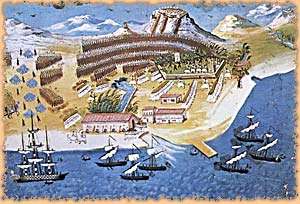Battle of the Lerna Mills
| Battle of the Lerna Mills | |||||||
|---|---|---|---|---|---|---|---|
| Part of the Greek War of Independence | |||||||
 | |||||||
| |||||||
| Belligerents | |||||||
|
|
| ||||||
| Commanders and leaders | |||||||
| Ioannis Makrygiannis Demetrios Ypsilantis Konstantinos Mavromichalis | Ibrahim Pasha of Egypt | ||||||
| Strength | |||||||
| 350 soldiers | 5000 soldiers | ||||||
| Casualties and losses | |||||||
| 2 | more than 500 | ||||||
The Battle of the Lerna Mills was fought on June 24, 1825 in Lerna, Greece between the Egyptian forces of Ibrahim Pasha and Greek forces led by Captain Ioannis Makrygiannis, Demetrios Ypsilantis and Konstantinos Mavromichalis.[1]
Battle
After the Greek army (led by Theodoros Kolokotronis) fled to Karitena, Ibrahim's forces captured Tripolitsa, which was completely abandoned. Immediately afterwards, Ibrahim sent 5000 soldiers to the plains of Argos in order to seize Nafplion. When Ibrahim's forces reached the mills of Lerna on June 24, Captain Makrygiannis and Mavromichalis organized a resistance force containing 350 Greek soldiers (Walter Alison Phillips places the number at 250[2]). Prince Demetrios Ypsilantis and several philhellenes volunteered in the defense of the garrison.[1]
Protecting Lerna was vital since the mills contained large quantities of grain that supplied food to Nafplion. The mills of Lerna were surrounded by a stone wall that was flanked by a deep pond and a marsh. Moreover, the garrison was supported by two gunboats that were anchored a short distance (or "musket-shot distance") from the shore. Unfortunately, the Greeks did not repair a small break in the stone wall. As a result, a small contingent of Arabs exploited this weakness in the defensive structure and attempted to create an entrance by increasing the size of the break. When the Arabs forced themselves through the break, they were prevented from regrouping once they entered the courtyard. Thirteen Arabs were killed by a charge of Greeks and philhellenes led by Makrygiannis. Ultimately, the remaining Arabs in the overall contingent were forced to flee. The Greeks, afterwards, attempted to fill in the gap in the stone wall. Despite the constant reinforcements he received, Ibrahim was aware of the fact that the Greeks were prepared to staunchly defend the Lerna Mills and he eventually retreated to the plains of Argos. From there, Ibrahim took his army to Tripolitsa on June 29, 1825.[1]
General Makriyannis in his Memoirs provides a vivid description of the situation before and during the battle. He and his corps were defending Neokastro and Palaiokastro in Methoni until surrendered under conditions to Ibrahim due to thirst and exhaustion. He came to defend the position first with selected members of his company and then came Ypsilantis and Mavromihalis but they had very few people with them. After Makriyannis it was Gikas that brought his band and later Liakopoulos came from Nafplion with 50 people. The position was weak and they were very few compared to Ibrahim's army. Thus many were eager to leave using their horses or by fish boats but Makriyannis made sure all horses and fish boats were gone in secret. This made everybody more resolute in defending the position and they started digging trenches. Admiral De Rigny watched from aboard the helplessness of the Greeks and advised Makriyannis against defending the position but Makriyannis ignored him by saying:
"They are many indeed but we few have decided to die and have God on our side... And when the few decide to die, most times win... And if we die today we will die for our country and our religion and this death is a good one". "Tres bien" replied De Rigny.
The first wave of the Egyptians was repelled successfully and this made some French naval officers to come ashore and congratulate Makriyannis. He was indeed that day the heart of the defenders in Myloi and he was eager to help wherever there was need. Thus he was shot in the right hand from musket fire but kept it secret until the end of the battle. He claims he was recognized by some of Ibrahim's shooters that remembered him from Neokastro. He was taken to the French frigate of Admiral De Rigny to be treated afterwards. He estimated the Egyptian losses to 500-600 dead and more wounded. Greek casualties were 2 dead and 2 wounded. In his account of the battle he praises all the defenders who "fought that day like lions" in a desperate struggle to repel Ibrahim and save Nafplion.
See also
References
Sources
- Finlay, George. History of the Greek Revolution. Blackwood and Sons, 1861 (Harvard University).
- Phillips, Walter Alison. The War of Greek Independence, 1821 to 1833. Smith, Elder and Company, 1897 (University of Michigan).
- Makriyannis, Memoirs, IX Archived 2 October 2009 at the Wayback Machine.
Further reading
- General Makriyannis, Ἀπομνημονεύματα (Memoirs), Athens: 1907 (preface by Yannis Vlahogiannis; in Greek).